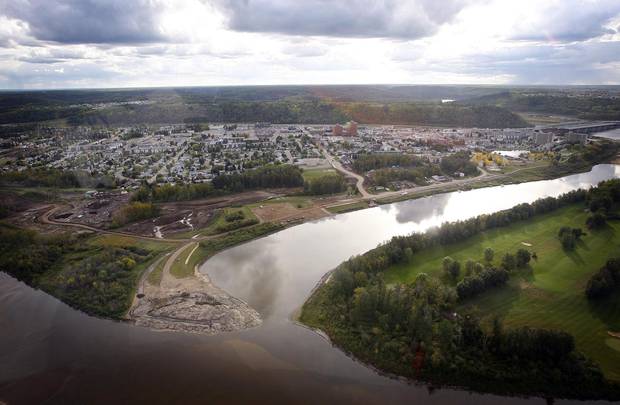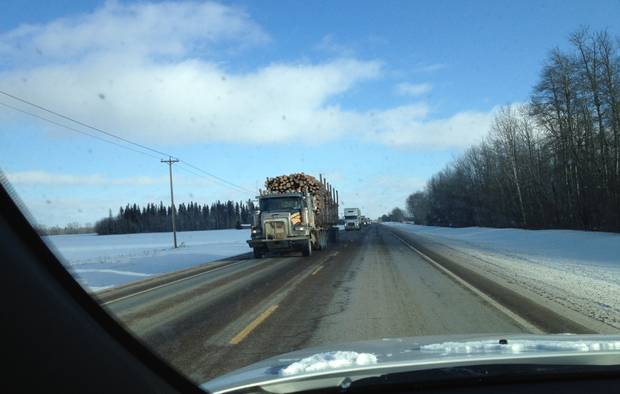Watch the wildfire raging along Highway 63
0:38
As late as Tuesday morning, officials confronting the wildfires outside Fort McMurray had warned local residents to pack their kits but remained hopeful that they wouldn't have to call for a mass evacuation.
"We're a long way off from that but that's something for people to bear in mind," Fort McMurray Fire Chief Darby Allen had said.
The conditions, however, already had all the ingredients for the kind of fast-spreading wildfire that hours later would force nearly 90,000 people, including nine newborns in hospital, to flee on short notice from the Alberta oil town.
The weather, the type of trees in the local forest, the time of the year and the kind of fire propagation were all indicators that the flames would be hard to tame, jumping over the Athabasca and Hangingstone rivers as they spread northward into the city.

An aerial view of downtown Fort McMurray on Sept. 19, 2011.
JEFF McINTOSH/THE CANADIAN PRESS
"The fire's behaviour was beyond all control efforts," Bernie Schmitte, wildfire manager at Alberta Agriculture and Forestry told reporters later in the night.
To make things worse, there had been an inversion, a weather condition where hot air at higher altitude traps down the smoke. However, by the end of the morning, the inversion reversed, Mr. Schmitte said, which would have fanned the flames and smoke further.
THE CROSSOVER
Brian Burnett, head instructor at Wildfire Specialists Inc., an Ontario training school, noted that the Fort McMurray area was experiencing a weather condition familiar to forest firefighters, the Crossover.
The Crossover happens when the numerical value for the ambient humidity is lower than the recorded temperature.
On Tuesday in Fort McMurray, while the mercury soared towards 30C, the humidity dropped to 15 per cent.
"It's just a recipe for a wildfire. This is such a difficult situation," Mr. Burnett said in an interview.
Such hot, dry conditions were made worse by the wind which pushed the flames toward the city.
Wildfires escalate in #FortMcMurray amid 30°C temperatures and gusty conditions https://t.co/iVZ1IyzdGw #ymmfire pic.twitter.com/FRb86hzgCu
— The Weather Network (@weathernetwork) May 3, 2016
The first alert was reported Sunday evening, when residents in the neighbourhood of Gregoire, at the southernmost end of Fort McMurray, were told to prepare to evacuate on short notice.
On Monday, officials thought that the fire, which was estimated to cover 500 to 750 hectares, had moved further away.
Within 24 hours, however, Mr. Schmitte was confirming that the fire had jumped the Athabasca, threatening the neighbourhoods on the north bank of the river bisecting Fort McMurray.
The fire on the north banks was five hectares in size and 15 kilometres away from residences.
Another river, the Hangingstone, still stood between the fire and the city's south-end neighbourhoods.
"That is somewhat of a break. But with current conditions, again, it will challenge that river," Mr. Schmitte told reporters at a briefing Tuesday.
By Wednesday morning, areas such as Beacon Hill, which were supposed to be protected by the Hangingstone, had sustained the heaviest damages from the fire.
CROWNING AND SPOTTING
Despite deploying helicopters, airplanes and bulldozer crews that cut down trees to create fire guards, the authorities faced flames that spread through crowning and spotting, two types of fast-moving fires.
"The issue with wind and our current conditions is spotting," Mr. Schmitte told the briefing.
"So, as the fire is burning, with a crown fire, there is always embers and pieces of bark and branches that are coming up in the atmosphere."
Spotting occurs when sparks, embers or burning debris are blown by the wind and start new blazes, away from direct contact with the main fire.
The fire that jumped over the Athabasca River was a spot fire, Mr. Schmitte said.
Mr. Burnett said he had seen situations where spotting enabled a forest fire to leap eight to 10 kilometres ahead of its main line.
Spot fires are also troublesome when they are near urban areas, he said, because embers ignite rooftops or rain gutters clogged with dead leaves and pine needles.
Crowning, the other problem mentioned by Mr. Schmitte, occurs when the fire spreads from branch to branch through the tree tops.
With crown fires, the flames can sometimes travel faster than a person running on the ground, Mr. Burnett said.
Crown fires are dangerous for firefighting ground crews, who have to pull back and rely solely on water-bomber planes or bucket-carrying helicopters.
THROUGH BLACK SPRUCE (AND ASPEN)

Spruce trees (left) and aspen (right) are shown along the highway to Fort McMurray in wintertime.
TRISH McALASTER/THE GLOBE AND MAIL
The types of trees in the area also exacerbate the problem.
"We have stands of black spruce, which are very volatile. And we have stands of white spruces intermixed with aspens… Those types of fuel are very challenging," Mr. Schmitte said.
Black spruce have fine branches and needles, which are more prone to ignite and to be blown away and produce spot fires, according to David Moseley, deputy fire chief at the Lac La Biche District.
Furthermore, "Black spruce more often has continuous branching from ground to crown, providing its own ladder fuel to spread a surface fire to a crown fire," Mr. Moseley wrote in an article last year for Fire Fighting in Canada magazine.
Aspens, which are deciduous trees, are also a fire hazard in May, the article added.
"With no green leaves on the aspen, sunlight and wind reach the forest floor, warming and drying it, creating conditions that will carry surface fire," Mr. Moseley noted.
MORE FROM THE GLOBE AND MAIL
Fort McMurray evacuee stresses need for a second highway out of the city
1:16


